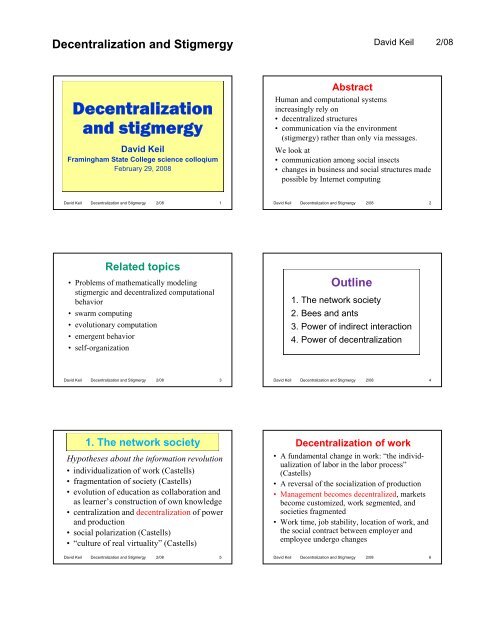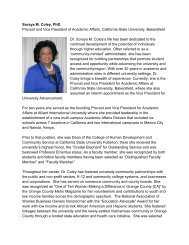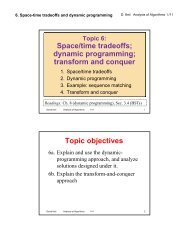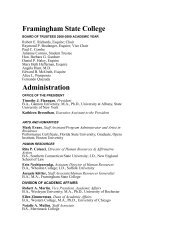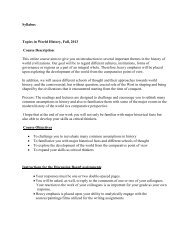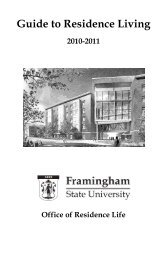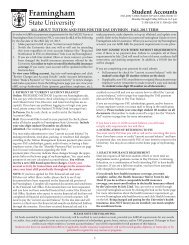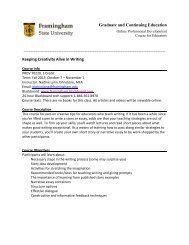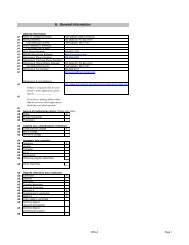Decentralization and stigmergy - Framingham State University
Decentralization and stigmergy - Framingham State University
Decentralization and stigmergy - Framingham State University
Create successful ePaper yourself
Turn your PDF publications into a flip-book with our unique Google optimized e-Paper software.
<strong>Decentralization</strong> <strong>and</strong> Stigmergy David Keil 2/08<br />
<strong>Decentralization</strong><br />
<strong>and</strong> <strong>stigmergy</strong><br />
David Keil<br />
<strong>Framingham</strong> <strong>State</strong> College science colloqium<br />
February 29, 2008<br />
David Keil <strong>Decentralization</strong> <strong>and</strong> Stigmergy 2/08<br />
Related topics<br />
• Problems of mathematically modeling<br />
stigmergic <strong>and</strong> decentralized computational<br />
behavior<br />
• swarm computing<br />
• evolutionary computation<br />
• emergent behavior<br />
• self-organization<br />
David Keil <strong>Decentralization</strong> <strong>and</strong> Stigmergy 2/08 3<br />
1. The network society<br />
Hypotheses about the information revolution<br />
• individualization of work (Castells)<br />
• fragmentation of society (Castells)<br />
• evolution of education as collaboration <strong>and</strong><br />
as learner’s construction of own knowledge<br />
• centralization <strong>and</strong> decentralization of power<br />
<strong>and</strong> production<br />
• social polarization (Castells)<br />
• “culture of real virtuality” (Castells)<br />
David Keil <strong>Decentralization</strong> <strong>and</strong> Stigmergy 2/08<br />
1<br />
5<br />
Abstract<br />
Human <strong>and</strong> computational systems<br />
increasingly rely on<br />
• decentralized structures<br />
• communication via the environment<br />
(<strong>stigmergy</strong>) rather than only via messages.<br />
We look at<br />
• communication among social insects<br />
• changes in business <strong>and</strong> social structures made<br />
possible by Internet computing<br />
David Keil <strong>Decentralization</strong> <strong>and</strong> Stigmergy 2/08 2<br />
Outline<br />
1. The network society<br />
2. Bees <strong>and</strong> ants<br />
3. Power of indirect interaction<br />
4. Power of decentralization<br />
David Keil <strong>Decentralization</strong> <strong>and</strong> Stigmergy 2/08 4<br />
<strong>Decentralization</strong> of work<br />
• A fundamental change in work: “the individualization<br />
of labor in the labor process”<br />
(Castells)<br />
• A reversal of the socialization of production<br />
•Management g becomes decentralized, , markets<br />
become customized, work segmented, <strong>and</strong><br />
societies fragmented<br />
• Work time, job stability, location of work, <strong>and</strong><br />
the social contract between employer <strong>and</strong><br />
employee undergo changes<br />
David Keil <strong>Decentralization</strong> <strong>and</strong> Stigmergy 2/08<br />
6
<strong>Decentralization</strong> <strong>and</strong> Stigmergy David Keil 2/08<br />
The global networked economy<br />
• Key new element: In a self-feeding spiral,<br />
progress in management, knowledge, <strong>and</strong><br />
technology is applied to these same three things<br />
• Compare with individual human learning, in<br />
which key element is self-reflection<br />
• Conjecture: As the brain’s neurons <strong>and</strong> their<br />
local connections provide infrastructure for<br />
self-reflection, likewise information technology<br />
provides infrastructure for the self-feeding<br />
spiral of the networked economy<br />
David Keil Information Technology <strong>and</strong> Society 1/08 7<br />
Organizational forms<br />
• Inter-firm networking<br />
• Corporate strategic alliances for specific aims,<br />
coexisting with competition<br />
• Shift from vertical bureaucracies to the<br />
horizontal corporation<br />
– flat hierarchy<br />
– organization around process not task<br />
– team management<br />
– customer-satisfaction-driven<br />
– retraining of employees<br />
– decentralization<br />
David Keil Information Technology <strong>and</strong> Society 1/08 9<br />
Wisdom of crowds<br />
• Necessary conditions:<br />
• Diversity<br />
• Independence<br />
• A “certain kind” of decentralization<br />
(S (Surowiecki, i ki 2004) )<br />
• Decentralized communication requires<br />
support media for collective wisdom to<br />
develop; e.g., stock market<br />
David Keil <strong>Decentralization</strong> <strong>and</strong> Stigmergy 2/08 11<br />
The network enterprise<br />
• Thesis: Informational-global economy is<br />
associated with “a new organizational<br />
logic” that converges <strong>and</strong> interacts with new<br />
technological paradigm<br />
• Mass production is converted to flexible<br />
production<br />
• Crisis, not of the large corporation, but of<br />
its traditional form of hierarchical, vertical<br />
integration <strong>and</strong> functional management<br />
David Keil Information Technology <strong>and</strong> Society 1/08 8<br />
Networks restructure society<br />
• Power relationships are made susceptible to<br />
major change by network organization of<br />
society<br />
• Power is held by people at the interfaces<br />
between networks<br />
• Global capitalist society is structured<br />
around a network of financial flows<br />
• Dominant functions in society are organized<br />
in networks, subordinate ones are<br />
fragmented<br />
David Keil Information Technology <strong>and</strong> Society 8/05 10<br />
2. Bees <strong>and</strong> ants<br />
• Bees communicate direction <strong>and</strong> distance of<br />
pollen sources by “waggle dance”, an example<br />
of message passing<br />
• Ants communicate via pheromone trails; the<br />
“message” g is the entire trail followed by yan<br />
ant, i.e., no single ant sends a message to<br />
another single ant<br />
• Conjecture: Difference in means of<br />
communication is due to difference in<br />
foraging environments<br />
David Keil <strong>Decentralization</strong> <strong>and</strong> Stigmergy 2/08 12
<strong>Decentralization</strong> <strong>and</strong> Stigmergy David Keil 2/08<br />
Food foraging problem for ants<br />
• Food is scattered r<strong>and</strong>omly<br />
• Task is to take it to the nest<br />
• Ants are small <strong>and</strong> limited in intelligence <strong>and</strong><br />
communicating power<br />
• Food may appear or disappear dynamically<br />
• A solution:<br />
– Ants walk semi-r<strong>and</strong>omly dropping pheromone<br />
– Ants tend also to follow pheromone trails<br />
– Ants carrying food drop special pheromone<br />
– Trails evolve toward short paths between nest<br />
<strong>and</strong> food<br />
David Keil Scalable models of multistream interaction 9/06 13<br />
Multi-stream <strong>and</strong><br />
indirect interaction<br />
• Multi-stream interaction occurs when an entity<br />
is concurrently interacting with more than one<br />
other entity<br />
•Let A <strong>and</strong> E interact asynchronously. If E may<br />
bbe ddecomposed d iinto t E' <strong>and</strong> d BB, where h E' = E –<br />
{B}, then A <strong>and</strong> B interact indirectly via E iff<br />
mutual causality holds between the behaviors<br />
of A <strong>and</strong> B.<br />
David Keil Scalable models of multistream interaction 9/06 15<br />
Decentralized “design”<br />
• Example artifacts:<br />
– The Internet<br />
– Natural language<br />
– Human society <strong>and</strong> culture<br />
– Evolution of life<br />
• Are any centralized processes capable of<br />
producing equally good results as current<br />
decentralized processes?<br />
David Keil Information Technology <strong>and</strong> Society 1/08 17<br />
Stigmergy in nature<br />
1.Termites gathering chips into pile:<br />
Move at r<strong>and</strong>om, pick up chip<br />
when encountered, put down<br />
when another chip found; the pile structure is used to<br />
coordinate creation of pile (StarLogo)<br />
2. Slime mold dividing <strong>and</strong> aggregating:<br />
These amoeba may aggregate by emitting a chemical,<br />
migrating toward its greatest concentration<br />
Q: Is <strong>stigmergy</strong> essential for some missions?<br />
David Keil Scalable models of multistream interaction 9/06 14<br />
3. Power of decentralization<br />
• The brain<br />
•Markets<br />
• Democracy<br />
• GGrowing i military ilit strength t th of f<br />
networks<br />
• Is decentralized coordination more<br />
powerful than centralized hierarchy?<br />
David Keil <strong>Decentralization</strong> <strong>and</strong> Stigmergy 2/08 16<br />
Multi-stream interaction<br />
• In contrast to sequential interaction, multistream<br />
interaction may feature:<br />
Nondeterminism when attempts to write<br />
collide<br />
Agents/processes<br />
Dynamic linking<br />
<strong>and</strong> unlinking,<br />
creation/destruction of nodes<br />
Indirect interaction via a shared<br />
environment<br />
David Keil Scalable models of multistream interaction 9/06 18
<strong>Decentralization</strong> <strong>and</strong> Stigmergy David Keil 2/08<br />
Decentralized, self-organizing systems<br />
• Decentralized <strong>and</strong> self-organizing systems lend<br />
themselves to flexibility <strong>and</strong> adaptiveness<br />
• Where required: in environments that are dynamic,<br />
persistent, multi-agent, decentralized, <strong>and</strong> self-organizing.<br />
Decentralized system: a multi-agent system whose<br />
components do not respond to comm<strong>and</strong>s from an active<br />
director or manager component, <strong>and</strong> do not execute<br />
prespecified synchronized roles under a design or plan.<br />
Self-organizing system: a multi-agent system with a coherent<br />
global structure or pattern shaped by local interactions<br />
among components, rather than by external forces.<br />
David Keil Scalable models of multistream interaction 9/06 19<br />
Indirect interaction <strong>and</strong><br />
multi-agent systems<br />
• In a MAS characterized by locality of interaction<br />
<strong>and</strong> mobility of agents, it is only possible for<br />
agents to influence overall system behavior by use<br />
of indirect interaction<br />
• Richness of multiagent interaction:<br />
– It is due partly to ability of each agent to<br />
interact with multiple others<br />
– Hence each agent interacts indirectly with all<br />
others (otherwise system partitions)<br />
David Keil Scalable models of multistream interaction 9/06 21<br />
Limitations of the<br />
message-passing model<br />
• Message passing does not support properties of indirect<br />
interaction: anonymity, asynchrony, space decoupling,<br />
non-intentionality, <strong>and</strong> late binding<br />
• Embedded <strong>and</strong> situated systems aren’t supported<br />
• SSuppose agents A <strong>and</strong> d B communicate i via i shared h d<br />
variable X<br />
– The message-passing model<br />
accounts for direct A ↔X <strong>and</strong><br />
B ↔ X interaction .<br />
– …but not between A <strong>and</strong> B via X<br />
Keil dissertation proposal 23<br />
4. Power of indirect interaction<br />
• Stigmergy enables agents to interact with<br />
more other agents without communications<br />
<strong>and</strong> storage overhead<br />
• Asynchronous multi-stream interaction<br />
entails il nondeterminism, d i i an element l of f<br />
evolutionary adaptation<br />
• Example: creation of a pheromone trail<br />
exploits past experience <strong>and</strong> explores an<br />
unknown foraging trail space<br />
David Keil <strong>Decentralization</strong> <strong>and</strong> Stigmergy 2/08 20<br />
The message-passing model<br />
of concurrency<br />
• Due to Robin Milner: CCS, π Calculus; associated<br />
with theory of concurrency <strong>and</strong> with process<br />
algebra<br />
• These models capture the notion of direct<br />
iinteraction t ti bby message passing i<br />
• Axiom of concurrency theory:<br />
interaction = message passing<br />
i.e., atomic communication of a message from one<br />
process to another (targeted send/receive)<br />
• Shared variables are deemed processes<br />
Keil dissertation proposal 22<br />
Unscalability of message passing<br />
• Motivation: As unscalable architectures in AI are<br />
brittle <strong>and</strong> will fail in realistic settings (R. Brooks),<br />
likewise for unscalable MAS architectures <strong>and</strong><br />
models<br />
• Hypothesis: As the number of agents rises<br />
asymptotically, t ti ll either ith number b of f connections ti<br />
grows too fast, or else paths between agents<br />
become too long<br />
• Other dimensions to show unscalability:<br />
– Synchronization vs. asynchrony<br />
– Centralized vs. decentralized storage<br />
Keil dissertation proposal 24
<strong>Decentralization</strong> <strong>and</strong> Stigmergy David Keil 2/08<br />
Some notions of MAS scalability<br />
• Scalable MAS instance: one that can perform a<br />
class of missions (hence satisfying their<br />
constraints) regardless of the number of agents nA<br />
or environmental entities nE<br />
• Statically-scalable MAS (w.r.t. a class of<br />
missions): ) one that is scalable under the<br />
assumption that agents <strong>and</strong> environmental entities<br />
are present at startup time<br />
• Dynamically-scalable MAS: one that is scalable<br />
under the more rigorous assumption that agents<br />
<strong>and</strong> environmental entities may appear or<br />
disappear during execution<br />
David Keil Scalable models of multistream interaction 9/06 25<br />
References<br />
Manuel Castells. Rise of the Network Society, 2nd ed. Blackwell,<br />
2000.<br />
David Keil <strong>and</strong> Dina Goldin. Modeling Indirect Interaction in<br />
Environments for Multi-Agent Systems In Proc. E4MAS, 2005.<br />
James Kennedy <strong>and</strong> Russell Eberhart. Swarm Intelligence.<br />
Morgan Kaufmann, 2001.<br />
Robin Milner. Communicating <strong>and</strong> Mobile Systems: The π<br />
Calculus. Cambridge, 1999.<br />
Mitchel Resnick. Turtles, Termites, <strong>and</strong> Traffic Jams. MIT Press,<br />
1994.<br />
James Surowiecki. The Wisdom of Crowds. Anchor Books, 2004.<br />
Peter Wegner. Why interaction is more powerful than<br />
algorithms. CACM 40 (5), 1997.<br />
David Keil <strong>Decentralization</strong> <strong>and</strong> Stigmergy 2/08<br />
26


